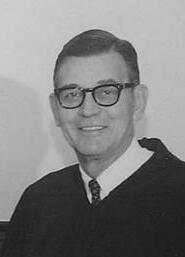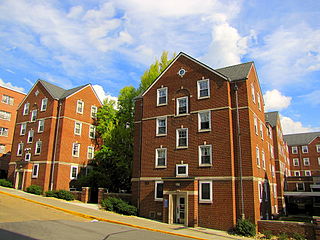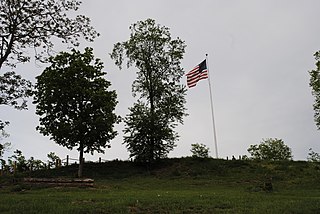
Arthur Ingram Boreman was an American lawyer, politician and judge who helped found the U.S. state of West Virginia. Raised in Tyler County, West Virginia, he served as the state's first Governor, and a United States senator, as well as represented Wood County in the Virginia House of Delegates, and served as a circuit judge before and after his federal service.

Boreman Hall is a residence hall on the campus of West Virginia University in Morgantown, West Virginia. Originally called Men's Hall when it was constructed in 1935, the hall is named after Arthur I. Boreman, the first governor of the state of West Virginia.

Daniel Duane Tompkins Farnsworth was an American politician in the U.S. state of West Virginia, who served in the West Virginia Senate and briefly as the second Governor of West Virginia.

Linda Lovelace was an American pornographic actress who became famous for her performance in the 1972 hardcore film Deep Throat. Although the film was an enormous success, Boreman later said that her abusive husband, Chuck Traynor, had threatened and coerced her into participation. In her autobiography Ordeal, she described what went on behind the scenes. She later became a born-again Christian and a spokeswoman for the anti-pornography movement.

This is a list of the National Register of Historic Places listings in Wood County, West Virginia.

Herbert Stephenson Boreman was a United States circuit judge of the United States Court of Appeals for the Fourth Circuit and previously was a United States district judge of the United States District Court for the Northern District of West Virginia.

John A. Field Jr. was a United States circuit judge of the United States Court of Appeals for the Fourth Circuit and previously was a United States district judge of the United States District Court for the Southern District of West Virginia.
Charles Ferguson Paul was a United States district judge of the United States District Court for the Northern District of West Virginia.
Mary Ireland Farnsworth (1830–1923) was the wife of former Governor of West Virginia Daniel D. T. Farnsworth and served as that state's First Lady, 1869. She was born on May 1, 1830, at Upshur County, West Virginia, a niece of Confederate General Thomas "Stonewall" Jackson. She holds the distinction of serving only five days as first lady; her husband completed the unexpired term of Arthur I. Boreman, who had resigned to enter the United States Senate. After leaving office, the Farnsworths moved to Buckhannon, West Virginia. She died on February 22, 1923.
Laurane Tanner Bullock Boreman was the wife of former Governor of West Virginia Arthur I. Boreman and served as that state's First Lady, 1869. She was born on May 1, 1830, at Wheeling, Virginia. Her first husband, John Oldham Bullock, was a Union soldier killed early in the Civil War. On November 30, 1864, she married Arthur I. Boreman. She helped define the role of the first lady, hosting formal gatherings at the Boreman's home in Wheeling. After leaving office, the Boremans moved to Washington, D.C. where Gov. Boremen served one term in the United States Senate and then to Parkersburg, West Virginia, where she died on April 14, 1908.
Boreman is a surname. Notable people with the surname include:

The 1868–69 United States Senate elections were held on various dates in various states. As these U.S. Senate elections were prior to the ratification of the Seventeenth Amendment in 1913, senators were chosen by state legislatures. Senators were elected over a wide range of time throughout 1868 and 1869, and a seat may have been filled months late or remained vacant due to legislative deadlock. In these elections, terms were up for the senators in Class 1.

Men's Hall, also known as Boreman Hall South, is a historic dormitory associated with the West Virginia University and located at Morgantown, Monongalia County, West Virginia. It was built in 1935, and is a five-story, "E"-shaped red brick building with Classical Revival detailing. It sits on a reinforced concrete foundation and has a slate covered gable roof. When documented in 1989, it housed 350 students in 329 rooms. It was the first dormitory built for men on campus. Its construction was funded in part by the Works Progress Administration. During World War II, it was used as an Air Force barracks.

Fort Boreman is a historic archaeological site encompassing a Civil War fortification located near Parkersburg, Wood County, West Virginia. It was built in 1863, by Company A of the 11th West Virginia Volunteer Infantry Regiment. It is a series of paired, approximately four foot deep trenches encircling the top of the hill in a zigzag pattern. It was originally built to ensure that the Baltimore and Ohio Railroad link between Wheeling and Parkersburg was not severed or commandeered by the Confederate army. The fort was named after Arthur I. Boreman, West Virginia's first Governor.
James Sanders Wheat was the Attorney General of Virginia in Union held territory from 1861 to 1863.
Jacob S. Boreman was a justice of the Supreme Court of the Utah Territory from 1873 to 1880, and again from 1885 to 1889.

The 1863 West Virginia gubernatorial election, held on May 28, resulted in the victory of Arthur I. Boreman. He received the nomination of the Unconditional Union Party and won with no opposition in the general election.
James McNeil Stephenson was an American lawyer, businessman and politician who served several terms in the Virginia House of Delegates representing western Virginia counties which in his lifetime became part of the state of West Virginia. His is probably not related to James Stephenson who represented western Virginia counties in the Virginia House of Delegates and U.S. Congress, nor schoolteacher Benjamin L. Stephenson (1826-1871) of Clay County, West Virginia who helped found the new state.
Granville Davisson Hall was an American journalist, businessman and politician who helped found the state of West Virginia during the American Civil War. He served as the Secretary of State of West Virginia and as the private secretary of the first governor, Arthur Boreman, and eventually wrote seven books, including The Rending of Virginia to counteract the growing Lost Cause myth. After the Civil War, Hall became involved in the railroad industry in Kentucky, eventually becoming President of the Louisville and Nashville Railroad, but later moved to Glencoe, Illinois where he continued writing and served as the village clerk.













